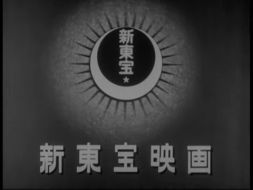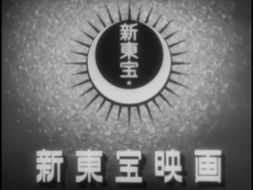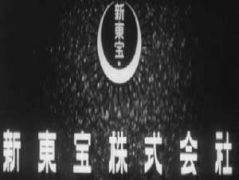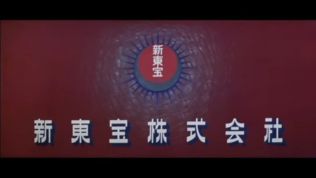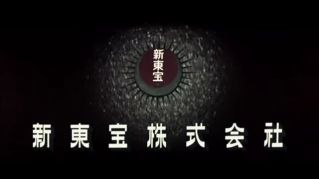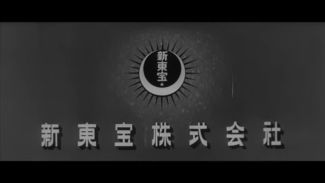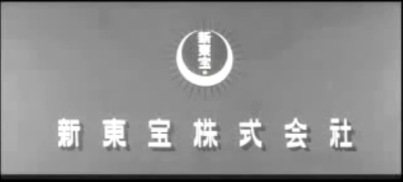Shintoho (Japan)
Jump to navigation
Jump to search
Logo descriptions by Yukabacera
Video captures courtesy of shimomov
1st Logo
(1947)
Logo: On a stone-like background, an elliptical plate featuring the raised words "SHINTOHO PICTURES" may be seen. Below it, the same words in Japanese are projected at an angle and on a foggy backdrop. The fog intensifies, almost covering the bottom half of the screen, and the words change color from white to black.
Variant: A variant exists where the projected words and their background remain still and do not change in any way.
FX/SFX: The scene fades in and out of view, the projected words change color, and their foggy backdrop expands.
Music/Sounds: None.
Availability: Seen on some films produced by Shintoho in 1947.
Editor's Note: None.
2nd Logo
(1947-1956)
FX/SFX: The scene fades in and out of view.
Music/Sounds: The bell ringing. The tone of the bell also changed as well.
Availability:Somewhat common, but Shintoho-produced films from this period that were distributed by Toho often only carried a Toho logo. Examples of films with this logo include Hiroshi Shimizu'sA Mother's Love(Bojo), Kenji Mizoguchi'sPortrait of Madame Yuki (Yuki fujin ezu), Mikio Naruse'sGinza Cosmetics(Ginza kesho), Kunio Watanabe'sGeisha Waltz(Geisha warutsu), Yutaka Abe'sBattleship Yamato(Senkan Yamato), Heinosuke Gosho'sWhere Chimneys are Seen(Entotsu no mieru basho) and Shue Matsubayashi'sHuman Torpedo Kaiten(Ningen gyorai Kaiten). The anniversary variant is presumably seen on some 1954 films.
Editor's Note: TBA
3rd Logo
(1955-1958)
Logo: On a patterned background, the elliptical Shintoho logo and the Japanese name of the company are casting a long shadow that extends to the lower right in semi-darkness. As a light source (presumably located to the left and slightly above the logo) moves to the right, the shadow become shorter and the entire scene becomes more strongly illuminated.
4th Logo
(1957-1958)
Logo: The elliptical Shintoho logo and the Japanese name of the company are set in yellow on a dark red background. The scene fades out after several seconds, but fades back to another one against the same background. Two phrases, "新東宝シネスコ" ("Shintoho Cinescope", white on a gray strip made to look like a wide film projection screen) and "イーストマンカラー" ("Eastmancolor") can be seen; the scene then fades out.
Variant: Sometimes, the second part advertising the technical features of the film is not shown.
FX/SFX: The scene fades in and out of view.
Music/Sounds: None, or the opening theme of the film.
Availability: Seen on widescreen color films produced by Shintoho in 1957 and 1958. An example is Kunio Watanabe's The Emperor Meiji and the Great Russo-Japanese War (Meiji-tenno to nichiro daisenso).
Editor's Note: None.
5th Logo
(1957-1960?)
Logo: We see a partially eclipsed sun with a small star and the word "新東宝" (Shintoho) on the black circle. Below this symbol, the full Japanesen ame of the company can be seen.
Variant: A variant where the entire shot is more zoomed-in exists. In it, the Japanese name of the company casts a longer shadow and the area covered by the lights behind the sun symbol is wider.
FX/SFX: Two large sets of pinpricks of light rotate in opposite directions in a small area behind the sun symbol.
Music/Sounds: None
Availability: Presumably seen on Academy ratio B&W films produced between 1957 and 1960; examples include Nobuo Nakagawa's The Ghosts of Kasane Swamp (Kaidan Kasane-ga-fuchi) and Goro Kadono's The Mother Tree (Kaidan chibusa enoki). The current DVD issue of the 1949 film Kazuo Hasegawa's Zenigata Heiji Detective Story: Heiji Covers All of Edo (Hasegawa Kazuo no Zenigata Heiji torimonohikae: Heiji happyakuyacho) also has this logo at the beginning, presumably being sourced from a theatrical re-release.
Editor's Note: None.
6th Logo
(1958-1961)
Logo: The Shintoho sun symbol is in the upper center of the screen, with the spinning white lights behind it. Below it, the Japanese name of the company has been extended to display the full legal name "新東宝株式会社" (Shintoho Co., Ltd.). The background is red.
Variants:
FX/SFX: Two large sets of pinpricks of light rotate in opposite directions in a small area behind the sun symbol.
Music/Sounds: None
Availability: The several variants of this logo are seen on various films produced during Shintoho's last years from late 1958 to October 1961. For example, the standard red variant precedes Kiyoshi Komori's The Greater East Asia War and International Trials (Daitoa senso to kokusai saiban), Yoshihiro Ishikawa's The Ghost Cat of Otama Pond (Kaibyo Otama-ga-ike), Yoshiki Onoda's Female Slave Ship (Onna dorei-sen),Teruo Ishii's Yellow Line (Osen chitai), and Nobuo Nakagawa's Hell (Jigoku). The monochrome variant of the same logo can be seen on Nobuo Nakagawa's The Mansion of the Ghost Cat (Borei kaibyo yashiki), The Woman Vampire (Onna kyuketsuki) and Death Row Woman (Onna shikeishu no datsugoku), Teruo Ishii's Black Line (Kurosen chitai) and Goro Kadono's Ghost of the Girl Diver (Kaidan ama yurei) and Decisive Battle at Kuroda Castle (Gozonji Kuroda-bushi: kessen Kuroda-jo). It can also be seen on the trailer for Morihei Magatani's Blood Sword of the 99th Virgin; the film itself uses the next logo.
Editor's Note: None.
7th Logo
(1959-1961)
Logo: The logo features Shintoho's previous logo, the word "SHINTOHO" inside an ellipse, and the full legal name of the company in Japanese below it, both in white on a red background. The logo is entirely still. The writing is illuminated from the left and therefore casts a shadow to the lower right.
Variants: Two black and white variants are known to exist, shot from slightly different angles with slight variants in the strength of the illumination.
FX/SFX: None.
Music/Sounds: None or the opening theme of the film. The trailer for Teruo Ishii's Sexy Line uses the ringing bell of the older logos, yet the film itself uses a short musical piece linked to the opening theme.
Availability: This logo is seen on various films produced during Shintoho's final period, between September 1959 and October 1961. It is also seen on films distributed by Shintoho. For example, the monochrome variant can be seen on Morihei Magatani's Blood Sword of the 99th Virgin (Kyujukyu-honme no kimusume) Teruo Ishii's Sexy Line (Sekushii chitai), Hiromichi Takebe's Fire Line (Kasen chitai) and Susumu Hani's Bad Boys (Furyo shonen).
Editor's Note: None.
Video captures courtesy of shimomov
Editions by Gilblitz112 and AlexFlanFanatic
Background: Shintoho Pictures Corporation was a Japanese film production and distribution company. It splintered from major company Toho in 1947 because of disagreements on labor organization and management within the company (its name means "New Toho"). Toho distributed many Shintoho-produced films and Shintoho was initially a subsidiary of Toho, but this arrangement didn't last. With the arrival of producer Mitsugu Okura in 1955, Shintoho attained its reputation of a producer of low-budget genre titles: horror, mystery and war films at first, but later becoming more daring with sexploitation films. It was the smallest of the so-called "Big Six" Japanese film studios of the 1950s, and declared bankruptcy in October 1961 after the release of the film Hell (Jigoku), directed by Nobuo Nakagawa, but its last film was 1962's Kanashimi wa itsumo haha ni, released theatrically by Daiei and also directed by Nakagawa.
A company under the same name was founded by an ex-Shintoho employee almost immediately after Shintoho's bankruptcy, but this "new Shintoho" (which still exists today) is unrelated to the pre-1961 Shintoho except in name.
Background: Shintoho Pictures Corporation was a Japanese film production and distribution company. It splintered from major company Toho in 1947 because of disagreements on labor organization and management within the company (its name means "New Toho"). Toho distributed many Shintoho-produced films and Shintoho was initially a subsidiary of Toho, but this arrangement didn't last. With the arrival of producer Mitsugu Okura in 1955, Shintoho attained its reputation of a producer of low-budget genre titles: horror, mystery and war films at first, but later becoming more daring with sexploitation films. It was the smallest of the so-called "Big Six" Japanese film studios of the 1950s, and declared bankruptcy in October 1961 after the release of the film Hell (Jigoku), directed by Nobuo Nakagawa, but its last film was 1962's Kanashimi wa itsumo haha ni, released theatrically by Daiei and also directed by Nakagawa.
A company under the same name was founded by an ex-Shintoho employee almost immediately after Shintoho's bankruptcy, but this "new Shintoho" (which still exists today) is unrelated to the pre-1961 Shintoho except in name.
1st Logo
(1947)
<iframe frameborder="0" height="207" src="http://wikifoundrytools.com/wiki/closinglogos/widget/genericvideo/5b03c12dd7158406bede5438df90f8025bfa77d8" width="273"></iframe><iframe frameborder="0" height="209" src="http://wikifoundrytools.com/wiki/closinglogos/widget/genericvideo/129d40f91babdc42b0c986c10a2691d817ff2ab5" width="278"></iframe>
Logo: On a stone-like background, an elliptical plate featuring the raised words "SHINTOHO PICTURES" may be seen. Below it, the same words in Japanese are projected at an angle and on a foggy backdrop. The fog intensifies, almost covering the bottom half of the screen, and the words change color from white to black.
Variant: A variant exists where the projected words and their background remain still and do not change in any way.
FX/SFX: The scene fades in and out of view, the projected words change color, and their foggy backdrop expands.
Music/Sounds: None.
Availability: Seen on some films produced by Shintoho in 1947.
Editor's Note: None.
2nd Logo
(1947-1956)
<iframe frameborder="0" height="166" src="http://wikifoundrytools.com/wiki/closinglogos/widget/genericvideo/9cb1fd1bc69337dd7a5de6f4d5108605709e1be7" width="219"></iframe><iframe frameborder="0" height="169" src="http://wikifoundrytools.com/wiki/closinglogos/widget/genericvideo/1b01cb8943fab0ca1ddec331aae0a746ad4dd9e9" width="223"></iframe><iframe frameborder="0" height="167" src="http://wikifoundrytools.com/wiki/closinglogos/widget/genericvideo/8ada80c7deabd77e6e4e9a3b795e0cc44e798040" width="220"></iframe><iframe frameborder="0" height="169" src="http://wikifoundrytools.com/wiki/closinglogos/widget/genericvideo/9c4a3ca4cd5cb7f785bbb25f13e464f41d081283" width="220"></iframe><iframe frameborder="0" height="169" src="http://wikifoundrytools.com/wiki/closinglogos/widget/genericvideo/9e1096cd72880b3572bf52d9562fc3140559c904" width="222"></iframe><iframe frameborder="0" height="169" src="http://wikifoundrytools.com/wiki/closinglogos/widget/genericvideo/cc03132425d3275b9db30e6a931f5aa877a66f80" width="220"></iframe><iframe frameborder="0" height="169" src="http://wikifoundrytools.com/wiki/closinglogos/widget/genericvideo/263800e6c023f4272474caa0c4f20a52f5910787" width="220"></iframe><iframe frameborder="0" height="170" src="http://wikifoundrytools.com/wiki/closinglogos/widget/genericvideo/4f5cb538c427675c9eda136b2c72888fd0f5c04a" width="223"></iframe><iframe frameborder="0" height="169" src="http://wikifoundrytools.com/wiki/closinglogos/widget/genericvideo/7c22acd1d34874f23090e34a5b0cd7eca60f2250" width="220"></iframe>
Logo: A bell with vines above and to the right of it may be seen. It rings several times, swinging back and forth on an obscure backdrop. The elliptical "SHINTOHO PICTURES" logo, the Japanese words "新東宝映画" (Shintoho Pictures) set in white and angled away from the viewer, and a small copyright notice reading "COPYRIGHT MCMXL VII BY SHINTOHO PICTURES CORPORATION" are projected over the scene.
Variant: The logo was updated with the pass of the time:
- In 1948, the bell is now larger (and therefore more resonant, providing a deeper sound) and swings more slowly, and is framed by stone. The elliptical logo now only reads "SHINTOHO", it is also wider and smaller in height. The Japanese words are no longer at an angle and are set in a different typeface. The copyright notice is set in a more narrow typeface than the previous, and reads "COPYRIGHT MCMXL VIII BY SHINTOHO PICTURES CORPORATION".
- In 1949, the bell has been changed yet again, to a bell smaller than both of the previous ones, but more ornately decorated. It is framed by leaves on both sides and above it. The elliptical logo is similarly shaped to the pre-1948 logo, and the word "SHINTOHO" inside it is set in a different typeface. At the beginning of the scene, it is partially transparent, but turns to white quickly. After it does, the year "1949" fades into view below it. The backdrop is of a cloudy sky.
- In 1950, the bell is a different (yet almost identical) one. The backdrop of clouds on a sky is much clearer. The elliptical logo starts out as a solid white, and the year "1950" fades into view below it almost immediately.
- From 1950 to 1955, the same bell used in the 1950 logo, on a practically identical background, but framed by different leaves. The typeface of the word "SHINTOHO" inside the elliptical logo has been changed again, to a thinner one than the previous. The Japanese words "新東宝映画" (Shintoho Pictures) set in white may be seen below the elliptical logo.
- In 1953, the Japanese name of the company has been replaced with the phrase "新東宝配給" ("distributed by Shintoho") on an unfolded scroll.
- In 1956, a different bell is used, framed by flowers to the left and right, is used, and the elliptical logo and the Japanese name of the company are larger.
- A colorized version also appeared in 1956; the shot is zoomed out and the entire scene is in color. The sky is colored orange, and the flowers are red and white roses.
FX/SFX: The scene fades in and out of view.
Music/Sounds: The bell ringing. The tone of the bell also changed as well.
Availability:Somewhat common, but Shintoho-produced films from this period that were distributed by Toho often only carried a Toho logo. Examples of films with this logo include Hiroshi Shimizu'sA Mother's Love(Bojo), Kenji Mizoguchi'sPortrait of Madame Yuki (Yuki fujin ezu), Mikio Naruse'sGinza Cosmetics(Ginza kesho), Kunio Watanabe'sGeisha Waltz(Geisha warutsu), Yutaka Abe'sBattleship Yamato(Senkan Yamato), Heinosuke Gosho'sWhere Chimneys are Seen(Entotsu no mieru basho) and Shue Matsubayashi'sHuman Torpedo Kaiten(Ningen gyorai Kaiten). The anniversary variant is presumably seen on some 1954 films.
Editor's Note: TBA
3rd Logo
(1955-1958)
<iframe frameborder="0" height="207" src="http://wikifoundrytools.com/wiki/closinglogos/widget/genericvideo/b31d488f2f94b2283d04e2dabca3223d3494ad36" width="273"></iframe><iframe frameborder="0" height="209" src="http://wikifoundrytools.com/wiki/closinglogos/widget/genericvideo/09358524410f20e70a6141ca8da5e5ea00b609a6" width="277"></iframe>
Logo: On a patterned background, the elliptical Shintoho logo and the Japanese name of the company are casting a long shadow that extends to the lower right in semi-darkness. As a light source (presumably located to the left and slightly above the logo) moves to the right, the shadow become shorter and the entire scene becomes more strongly illuminated.
Variant: A colorized variant was used in Academy ratio color films. The Shintoho logo is seen colored orange on a light brown background, set in a shiny metal or plastic.
FX/SFX: Light effects. The colorized variant is still.
Music/Sounds: None, the opening theme of the film, or the bell sound heard in the previous logos.
Availability: Somewhat common; seen on some black and white films produced by Shintoho between 1955 and 1958. Examples include Hiroshi Shimizu's The Shiinomi School (Shiinomi gakuen), Masaki Mori's Ghost Story of Yotsuya (Yotsuya kaidan), Toshio Shimura's Admiral Yamamoto and the Allied Fleets (Gunshin Yamamoto gensui to rengo kantai) Kyotaro Namiki's The Military Policeman and the Dismembered Beauty (Kenpei to barabara shibijin), Tatsuo Yamada's Traitors of the Blue Castle (Ayaushi! Date rokujuniman-goku) and Nobuo Nakagawa's A Wicked Woman (Dokufu Takahashi Oden).
Editor's Note: None.
FX/SFX: Light effects. The colorized variant is still.
Music/Sounds: None, the opening theme of the film, or the bell sound heard in the previous logos.
Availability: Somewhat common; seen on some black and white films produced by Shintoho between 1955 and 1958. Examples include Hiroshi Shimizu's The Shiinomi School (Shiinomi gakuen), Masaki Mori's Ghost Story of Yotsuya (Yotsuya kaidan), Toshio Shimura's Admiral Yamamoto and the Allied Fleets (Gunshin Yamamoto gensui to rengo kantai) Kyotaro Namiki's The Military Policeman and the Dismembered Beauty (Kenpei to barabara shibijin), Tatsuo Yamada's Traitors of the Blue Castle (Ayaushi! Date rokujuniman-goku) and Nobuo Nakagawa's A Wicked Woman (Dokufu Takahashi Oden).
Editor's Note: None.
4th Logo
(1957-1958)
<iframe frameborder="0" height="186" src="http://wikifoundrytools.com/wiki/closinglogos/widget/genericvideo/9336afa55b95060bf06d1c5fefbb0fa3563c9549" width="325"></iframe><iframe frameborder="0" height="189" src="http://wikifoundrytools.com/wiki/closinglogos/widget/genericvideo/7e0b54820836f1d0dc29990ef27a435afc1afd24" width="330"></iframe>
Logo: The elliptical Shintoho logo and the Japanese name of the company are set in yellow on a dark red background. The scene fades out after several seconds, but fades back to another one against the same background. Two phrases, "新東宝シネスコ" ("Shintoho Cinescope", white on a gray strip made to look like a wide film projection screen) and "イーストマンカラー" ("Eastmancolor") can be seen; the scene then fades out.
Variant: Sometimes, the second part advertising the technical features of the film is not shown.
FX/SFX: The scene fades in and out of view.
Music/Sounds: None, or the opening theme of the film.
Availability: Seen on widescreen color films produced by Shintoho in 1957 and 1958. An example is Kunio Watanabe's The Emperor Meiji and the Great Russo-Japanese War (Meiji-tenno to nichiro daisenso).
Editor's Note: None.
5th Logo
(1957-1960?)
<iframe frameborder="0" height="171" src="http://wikifoundrytools.com/wiki/closinglogos/widget/genericvideo/628f0023da12f772816fcb99b5bd4f9ced3d4339" width="225"></iframe><iframe frameborder="0" height="171" src="http://wikifoundrytools.com/wiki/closinglogos/widget/genericvideo/834d929c5683381db0c12e131bc980a21eb8730d" width="225"></iframe>
Logo: We see a partially eclipsed sun with a small star and the word "新東宝" (Shintoho) on the black circle. Below this symbol, the full Japanesen ame of the company can be seen.
Variant: A variant where the entire shot is more zoomed-in exists. In it, the Japanese name of the company casts a longer shadow and the area covered by the lights behind the sun symbol is wider.
FX/SFX: Two large sets of pinpricks of light rotate in opposite directions in a small area behind the sun symbol.
Music/Sounds: None
Availability: Presumably seen on Academy ratio B&W films produced between 1957 and 1960; examples include Nobuo Nakagawa's The Ghosts of Kasane Swamp (Kaidan Kasane-ga-fuchi) and Goro Kadono's The Mother Tree (Kaidan chibusa enoki). The current DVD issue of the 1949 film Kazuo Hasegawa's Zenigata Heiji Detective Story: Heiji Covers All of Edo (Hasegawa Kazuo no Zenigata Heiji torimonohikae: Heiji happyakuyacho) also has this logo at the beginning, presumably being sourced from a theatrical re-release.
Editor's Note: None.
6th Logo
(1958-1961)
<iframe frameborder="0" height="154" src="http://wikifoundrytools.com/wiki/closinglogos/widget/genericvideo/a9dcedc4b9b37a10d38a488ab94b8b50d8b2cb9a" width="270"></iframe><iframe frameborder="0" height="154" src="http://wikifoundrytools.com/wiki/closinglogos/widget/genericvideo/4345d5411117883f58f456187c187495922250c4" width="270"></iframe><iframe frameborder="0" height="154" src="http://wikifoundrytools.com/wiki/closinglogos/widget/genericvideo/359403027eee503649563dfe5ed30751d97f01ef" width="270"></iframe>
Logo: The Shintoho sun symbol is in the upper center of the screen, with the spinning white lights behind it. Below it, the Japanese name of the company has been extended to display the full legal name "新東宝株式会社" (Shintoho Co., Ltd.). The background is red.
Variants:
- A variant with a black background in which the colors of the sun logo are less vibrant exists, as does a red-background variant with no moving lights: the sun symbol only has a black patch behind it.
- A black and white variant also exists.
- A variant that is completely still exists, featuring a gray background. Usually used in trailers.
FX/SFX: Two large sets of pinpricks of light rotate in opposite directions in a small area behind the sun symbol.
Music/Sounds: None
Availability: The several variants of this logo are seen on various films produced during Shintoho's last years from late 1958 to October 1961. For example, the standard red variant precedes Kiyoshi Komori's The Greater East Asia War and International Trials (Daitoa senso to kokusai saiban), Yoshihiro Ishikawa's The Ghost Cat of Otama Pond (Kaibyo Otama-ga-ike), Yoshiki Onoda's Female Slave Ship (Onna dorei-sen),Teruo Ishii's Yellow Line (Osen chitai), and Nobuo Nakagawa's Hell (Jigoku). The monochrome variant of the same logo can be seen on Nobuo Nakagawa's The Mansion of the Ghost Cat (Borei kaibyo yashiki), The Woman Vampire (Onna kyuketsuki) and Death Row Woman (Onna shikeishu no datsugoku), Teruo Ishii's Black Line (Kurosen chitai) and Goro Kadono's Ghost of the Girl Diver (Kaidan ama yurei) and Decisive Battle at Kuroda Castle (Gozonji Kuroda-bushi: kessen Kuroda-jo). It can also be seen on the trailer for Morihei Magatani's Blood Sword of the 99th Virgin; the film itself uses the next logo.
Editor's Note: None.
7th Logo
(1959-1961)
<iframe frameborder="0" height="170" src="http://wikifoundrytools.com/wiki/closinglogos/widget/genericvideo/5a24c4b92bd14b893c02678452bcdd2c804ab1d4" width="296"></iframe><iframe frameborder="0" height="171" src="http://wikifoundrytools.com/wiki/closinglogos/widget/genericvideo/b269450ec5bbd22a39157d739fc59cee3c37e011" width="299"></iframe><iframe frameborder="0" height="171" src="http://wikifoundrytools.com/wiki/closinglogos/widget/genericvideo/bbd2d14c3f20dba8e059acfffcbb092f13aeda58" width="299"></iframe>
Logo: The logo features Shintoho's previous logo, the word "SHINTOHO" inside an ellipse, and the full legal name of the company in Japanese below it, both in white on a red background. The logo is entirely still. The writing is illuminated from the left and therefore casts a shadow to the lower right.
Variants: Two black and white variants are known to exist, shot from slightly different angles with slight variants in the strength of the illumination.
FX/SFX: None.
Music/Sounds: None or the opening theme of the film. The trailer for Teruo Ishii's Sexy Line uses the ringing bell of the older logos, yet the film itself uses a short musical piece linked to the opening theme.
Availability: This logo is seen on various films produced during Shintoho's final period, between September 1959 and October 1961. It is also seen on films distributed by Shintoho. For example, the monochrome variant can be seen on Morihei Magatani's Blood Sword of the 99th Virgin (Kyujukyu-honme no kimusume) Teruo Ishii's Sexy Line (Sekushii chitai), Hiromichi Takebe's Fire Line (Kasen chitai) and Susumu Hani's Bad Boys (Furyo shonen).
Editor's Note: None.
